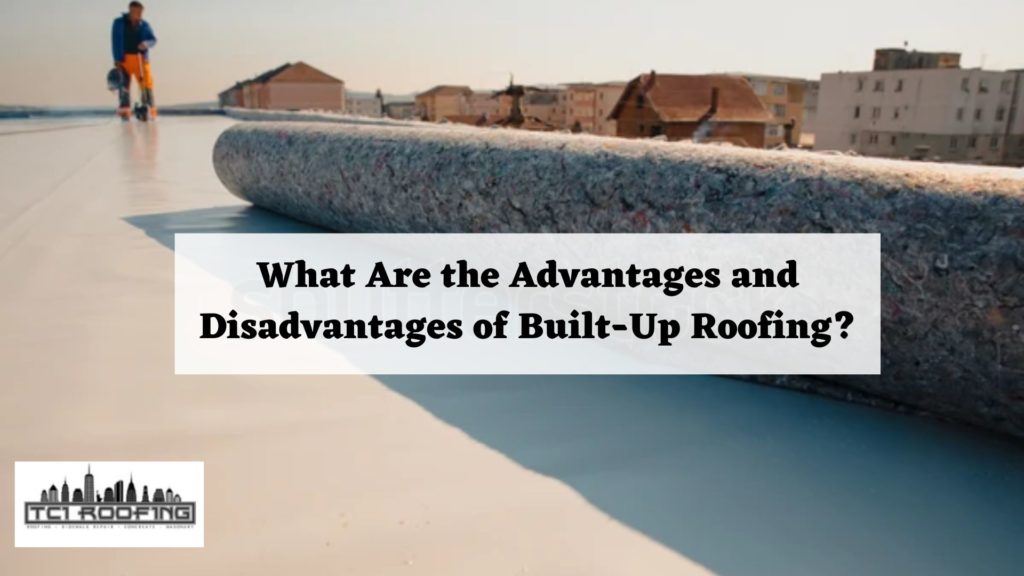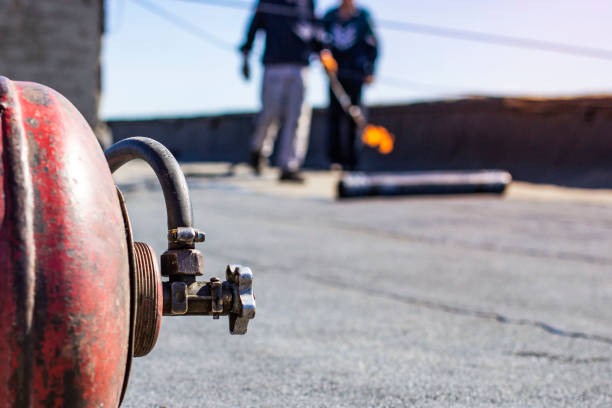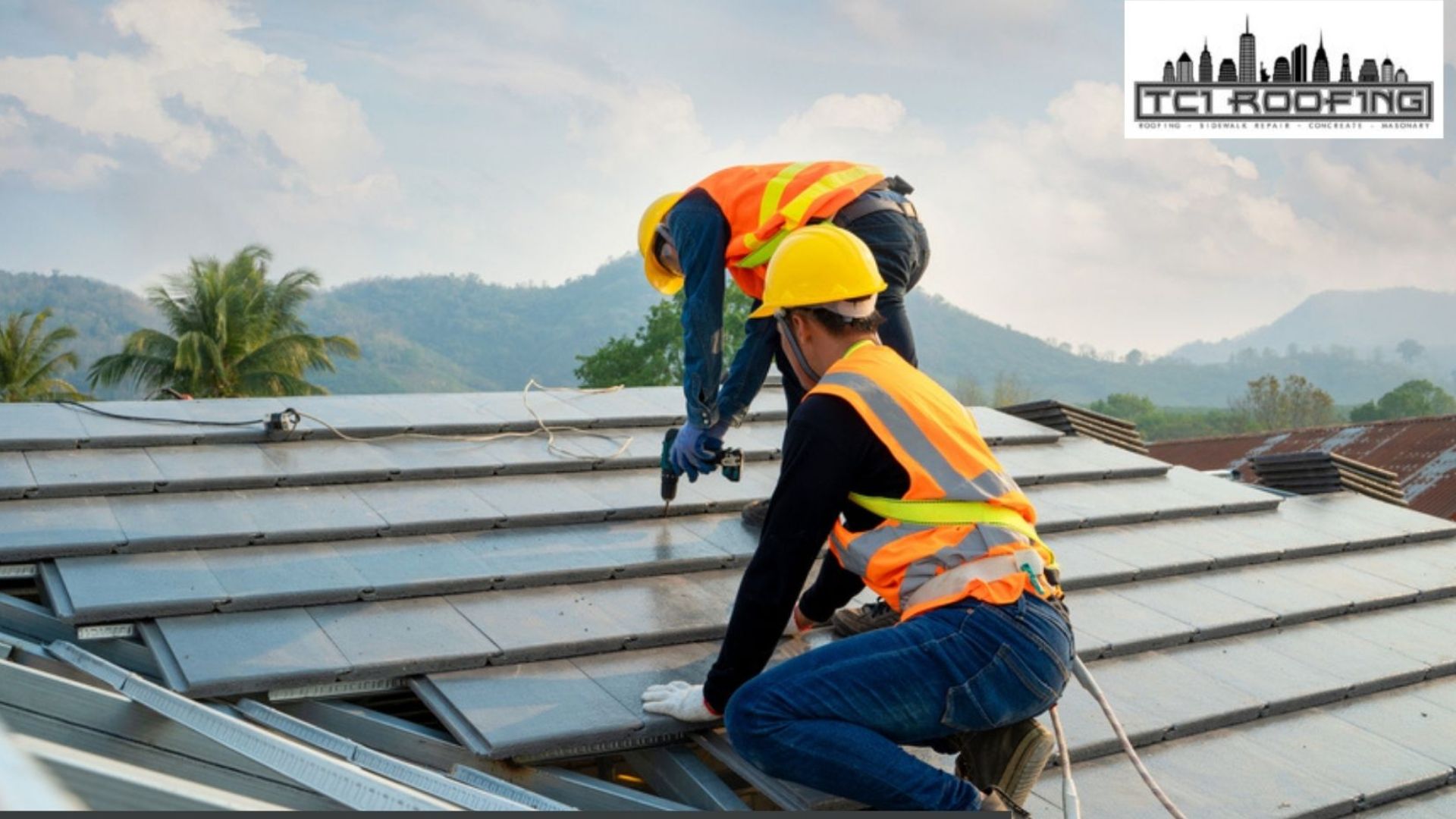Despite being a tried-and-true commercial roofing alternative, built-up roofs still require design. Built-up roof (BUR) systems were created in the 1800s and rose in popularity in the 1970s for commercial structures, but they are still used for a good reason. They last a very long time and are strong.
Built-up roofing makes up the largest market for roofing systems, with a market worth over $700 million. The sheer volume of flat-roofed commercial buildings in America older than 25 years accounts for that huge BUR roofing category (thin warehouses, factories, and fabrication centers).
Built-up roofing has many advantages, including its durability and ability to withstand extreme weather conditions. However, there are also some disadvantages to this type of roofing, including its high cost and the fact that it can be challenging to repair.
What Are the Types of Built-up Roofing?
Ballasted Roof
A ballasted roof is not fastened or bonded to the roof membrane. People were concerned about its durability when it was initially released. They were concerned that a powerful gust of wind would expose the deck because loose gravel was strewn all over it. This form of roofing employs larger-diameter gravel and stones. With the help of a few bolts and plates here and there, a thick coating is applied with minimal movement. Gravel is blasted onto the deck during installation, making it relatively simple. This roofing system may be installed whenever and under any conditions. Additionally, the stones are practically fireproof, placing BUR at the top of the list of fire-resistant roofing materials.
Hot Built-Up
Liquid bitumen is used on hot built-up roofs. Its installation is the most challenging compared to a cold built-up roof and a ballasted asphalt built-up roof. resistant and offers excellent ultraviolet protection. Even in regions with often changing climates, it lasts longer than the 15 to 30 years of expected life.
Cold Built-Up
Using a squeegee, a cold built-up roof is applied. The installation does not produce any hazardous emissions, and changes in the weather have no impact on how it is used.
What Are The Advantages of a Built-up Roofing System?
Aesthetic Enhancement: One of the advantages of built-up roofing is that it can offer an aesthetic enhancement to your property. When you have a commercial building, it is essential to ensure it looks its best. This means that you will want to choose a roofing system that will complement the overall look of your property or on your roof deck. With built-up roofing, you can choose from various colors and styles to find the perfect look for your property.
Protection Against the Elements: Another advantage of built-up roofing is that it can offer protection against the elements. This type of roofing is designed to withstand high winds and heavy rain. It is also resistant to fire, so you can rest assured that your property will be protected in the event of a fire.
Durable: One of the essential advantages of built-up roofing is that it is durable. When you invest in this type of roofing, you can rest assured that it will last many years. This is because it is made from high-quality materials like a mineral-surfaced cap sheet and a ply sheet that are designed to withstand the elements.
Long-Lasting: Another advantage of built-up roofing system is that it is long-lasting. You will not have to worry about replacing your roof with cover board anytime soon. With this type of roofing, you can expect it to last for decades.
Low Maintenance: One of the best advantages of built-up roofing is its low maintenance. This means you will not have to spend much time or money on maintaining your roof. You will also not have to worry about replacing your roof as often as you would with other types of roofing with asphalt coating of roof penetrations.
What Are The Disadvantages of Built-up Roofing Membrane?
High Cost: One of the main disadvantages of built-up roofing is its high cost. This type of roofing can be expensive to install, and it can also be costly to repair. Therefore, if you are on a tight budget, you may want to consider another type of roofing for your property.
Difficult to Repair: Another disadvantage of built-up roofing is that it can be challenging to repair. This is because the materials are bonded, making it challenging to replace individual components. If you need to improve your roof, you may need to hire a professional to do the job.
Not as Attractive: One of the main disadvantages of built-up roofing is that it is not as attractive as other types. This is because it can be bulky and can look industrial. If you are looking for a roofing system that will enhance the look of your property, you may want to consider another option.
Can Be Noisy: Another disadvantage of built-up roofing is that it can be noisy. This is because the materials are bonded together and can rub against each other when it rains, or the wind blows. If you live in an area that gets a lot of rain or wind, you may want to consider another type of roofing for your property.
Can Be Messy: Another disadvantage of built-up roofing is that it can be messy. This is because the installation process can generate a lot of dust and debris. If you have allergies or asthma, you may want to consider another low slope roofs type of roofing for your property.
How Long Does Built-Up Asphalt Roofing Last?
A built-up asphalt roofing can last anywhere from 15 to 30 years. However, the lifespan of your roof will depend on several factors, such as the quality of materials used, the installation process, and the maintenance regimen. If you want to prolong the life of your roof, it is essential to have it inspected and serviced regularly.
What Are Built-up Roofing Designed To Do?
Built-up roofing is a particularly specialized type of roofing used for well over a century. Built-up roofing details offers flat roof systems an extra layer of roof stability. Bitumen and reinforced fabric are applied in layers that are alternated during installation. According to the building or property manager’s preferred level of roof support, the number of strata will vary. The built-up roof’s highest layer of a flat surface, either rock or stone, shields the other layers from weather effects.
UV radiation, extremely cold or hot temperatures, and significant wind damage are adverse weather effects.
How is Built-Up Roofing Installed?
The installation process is as follows:
- A base layer of felt or fiberglass matting is first laid down.
- Hot asphalt is then applied to the matting, and another matting layer is placed on flat roofs.
- This process is repeated until the desired multiple layers has been reached.
- A gravel, stone, or slate layer of ply sheets is then placed on top to protect the other layers from UV damage and extreme weather conditions.
What Are the Basic Repairs of Built-up Roofing?
The most common repair is the replacement of damaged or missing gravel, stone, or slate on the top layer. This is because this layer is exposed to the elements and can become damaged over time. If you notice any bald spots on your roof, it is essential to have them repaired as soon as possible to prevent further damage.
Another common repair is the replacement of damaged or missing asphalt in the lower layers. This is because this material can become brittle and crack over time. If you notice any cracks in your roof, it is essential to have them repaired as soon as possible to prevent further damage on your roof decking and your roof insulation will have no problem.
Who Installs Built-up Roofing Near Me?
TCI Manhattan Roofing is the best roofing contractor in New York City. We have over 20 years of experience installing built-up roofing systems. We use only the highest quality materials, and our team of expert roofers is able to install your roof quickly and efficiently. Contact us today for a free estimate!
Thoughts
In conclusion, built-up roofing systems has many advantages and disadvantages that you should consider before deciding if it is the right roofing system for your property. Built-up roofing is a specialized roofing system used for over a century. It offers flat roof systems an extra layer of roof stability. In addition, the built-up roof’s highest layer, either rock or stone, shields the other layers from weather effects. When choosing built-up roofing contractors, select a reputable company with experience installing this type of roofing system, particularly TCI Manhattan Roofing.




